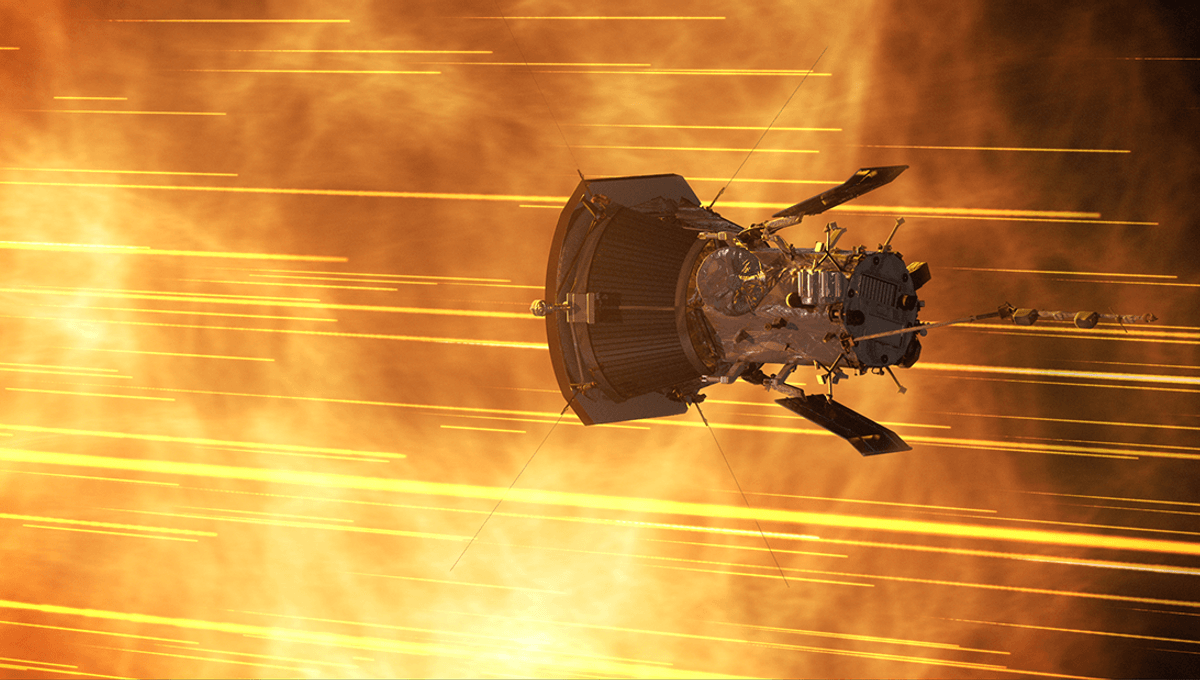
A study looking at data from NASA’s Parker Solar Probe has found evidence for a “helicity barrier” in the atmosphere of the Sun.
In 2018, NASA launched the Parker Solar Probe on a trajectory that would eventually have it dive into the Sun’s atmosphere (corona), getting seven times closer to our host star than any other spacecraft so far. In June 2025, the probe completed its 24th close approach to the Sun, whilst equaling its record for the fastest a human-made object has ever traveled, at a zippy 692,000 kilometers per hour (430,000 miles per hour).
The probe is aimed at studying the Sun’s atmosphere and will hopefully shed light on a few long-standing mysteries, such as how the solar wind is accelerated. One puzzle, first discovered in 1939, is that the Sun’s corona is far hotter than the solar surface. And not just by a little.
“The hottest part of the Sun is its core, where temperatures top 27 million °F (15 million °C). The part of the Sun we call its surface – the photosphere – is a relatively cool 10,000 °F (5,500 °C),” NASA explains. “In one of the Sun’s biggest mysteries, the Sun’s outer atmosphere, the corona, gets hotter the farther it stretches from the surface. The corona reaches up to 3.5 million °F (2 million °C) – much, much hotter than the photosphere.”
This is known as the “coronal heating problem”. The basic problem is this: why is the atmosphere far hotter than the surface, when the surface is much closer to the core, where energy is generated through the fusion of hydrogen into helium?
There have been suggestions that the extra heat in the corona is caused by turbulence, or a type of magnetic wave known as “ion cyclotron waves”.
“Both, however, have some problem—turbulence struggles to explain why hydrogen, helium and oxygen in the gas become as hot as they do, while electrons remain surprisingly cold; while the magnetic waves theory could explain this feature, there doesn’t seem to be enough of the waves coming off the sun’s surface to heat up the gas,” Dr Romain Meyrand, author on the new paper, explained in a previous statement.
While both ideas have problems, together with a “helicity barrier”, they show some promise for explaining the coronal heating problem.
“If we imagine plasma heating as occurring a bit like water flowing down a hill, with electrons heated right at the bottom, then the helicity barrier acts like a dam, stopping the flow and diverting its energy into ion cyclotron waves,” Meyrand added. “In this way, the helicity barrier links the two theories and resolves each of their individual problems.”
Essentially, the helicity “barrier” alters turbulent dissipation, changing how fluctuations dissipate and how the plasma is heated. The team has now analyzed data from the Parker Solar Probe, and it appears to show evidence for the helicity barrier.
“The barrier can form only under certain conditions, such as when thermal energy is relatively low compared to magnetic energy. Since fluctuations in the magnetic field are expected to behave differently when the barrier is active versus when it is not, measuring how these fluctuations vary with solar wind conditions relevant to the barrier’s formation—including the thermal-to-magnetic energy ratio—provides a way to test for the barrier’s presence,” the team explains in their paper.
“By analyzing solar wind magnetic field measurements, we find that the fluctuations behave exactly as predicted with changes in solar wind parameters that characterize these conditions. This analysis also allows us to identify specific values for these parameters that are needed for the barrier to form, and we find that these values are common near the Sun.”
Further analysis is necessary, but the approach looks fairly promising for explaining the problem.
“This paper is important as it provides clear evidence for the presence of the helicity barrier, which answers some long-standing questions about coronal heating and solar wind acceleration, such as the temperature signatures seen in the solar atmosphere, and the variability of different solar wind streams,” Dr Christopher Chen, study author and Reader in Space Plasma Physics at Queen Mary University of London, said in a statement.
“This allows us to better understand the fundamental physics of turbulent dissipation, the connection between small-scale physics and the global properties of the heliosphere, and make better predictions for space weather.”
While conducted on our own Sun (we are far from ready to plunge spacecraft into the atmosphere of other stars), the study has implications for other stars, and other parts of the universe, in other collisionless plasmas.
“This result is exciting because, by confirming the presence of the ‘helicity barrier’, we can account for properties of the solar wind that were previously unexplained, including that its protons are typically hotter than its electrons,” said Jack McIntyre, lead author and PhD student from Queen Mary University of London.
“By improving our understanding of turbulent dissipation, it could also have important implications for other systems in astrophysics.”
The study is published in Physical Review X.
Source Link: NASA's Parker Solar Probe Finds Evidence Of "Barrier" In The Sun's 2 Million Kelvin Atmosphere